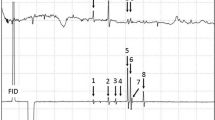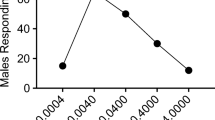Abstract
Trapping experiments were conducted in orchards to test the hypothesis that exposure of the mullein bug,Campylomma verbasci (Meyer), to atmospheres permeated with its synthetic sex pheromone, a 94:6 blend of butyl butyrate (BB) and (E)-crotyl butyrate (CB), or BB or CB alone, would alter the pheromone responses of males toward off-ratio blends. Exposure to the natural 94:6 blend shifted the response preference away from the natural ratio to blends enriched in BB, including a 99:1 blend, which is normally significantly less attractive than the natural ratio. In an atmosphere permeated with CB, male mullein bugs were as responsive to blends containing 20, 33, and 43% CB, up to seven times the natural percentage, as they were to the 94:6 blend. In an atmosphere permeated with BB, responses to five blends ranging from 94:6 to 99:1 BB:CB were not significantly different, whereas in an untreated atmosphere blends of 98:2 and 99:1 were significantly less attractive than the 94:6 blend. Individual components appeared to disrupt pheromone communication primarily through the creation of a sensory imbalance and modified interpretation of pheromone blend ratios, whereas disruption by the complete pheromone blend apparently involves several mechanisms, including false-trail following and camouflage. Disruption of pheromone communication was most effective with the natural 94:6 sex pheromone blend.
Similar content being viewed by others
References
Aldrich, J.R. 1988. Chemical ecology of the Heteroptera.Annu. Rev. Entomol. 33:211–238.
Baker, T.C., Hansson, B.S., Löfstedt, C., andLöfqvist, J. 1989. Adaptation of male moth antennal neurons in a pheromone plume is associated with cessation of pheromone-mediated flight.Chem. Senses 14:439–448.
Bartell, R.J. 1982. Mechanisms of communication disruption by pheromone in the control of Lepidoptera: a review.Physiol. Entomol. 7:353–364.
Carde, R.T. 1990. Principles of mating disruption, pp. 47–72,in R.L. Ridgway, R.M. Silverstein, and M.N. Inscoe (eds.). Behavior-Modifying Chemicals for Insect Management: Applications of Pheromones and Other Attractants. Marcel Dekker, New York.
Charmillot, P.-J. 1990. Mating disruption technique to control codling moth in western Switzerland, pp. 165–182,in R.L. Ridgway, R.M. Silverstein, and M.N. Inscoe (eds.). Behavior-Modifying Chemicals for Insect Management: Applications of Pheromones and Other Attractants. Marcel Dekker, New York.
Cochran, W.G., andCox, G.M. 1957. Experimental Designs, 2nd ed. Wiley, New York.
Figueredo, A.J., andBaker, T.C. 1992. Reduction of the response to sex pheromone in the oriental fruit moth,Grapholitha molesta (Lepidoptera: Tortricidae) following successive pheromonal exposures.J. Insect Behav. 5:347–363.
Flint, H.M., andMerkle, J.R. 1983. Pink bollworm (Lepidoptera: Gelechiidae): communication disruption by pheromone composition imbalance.J. Econ. Entomol. 77:1099–1104.
Flint, H.M., andMerkle, J.R. 1984. The pink bollworm (Lepidoptera: Gelechiidae): Alteration of male response to gossyplure by release of its component Z,Z-isomer.J. Econ. Entomol. 77:1099–1104.
Hirano, C. 1979. (Z)-9-Tetradecenyl acetate as a potent inhibitor of attraction ofSpodoptera litura (Lepidoptera: Noctuidae) to synthetic sex pheromone.Prot. Ecol. 1:171–177.
Huddelston, P.M., Mitchell, E.B., andWilson, N.M. 1977. Disruption of boll weevil communication.J. Econ. Entomol. 70:83–85.
Jutsum, A.R., andGordon, R.F.S. 1989. Pheromones: importance to insects and role in pest management, pp. 1–13,in A.R. Jutsum and R.F.S. Gordon (eds.). Insect Pheromones in Plant Protection. Wiley, New York.
Kuenen, L.P.S., andBaker, T.C. 1981. Habituation versus sensory adaptation as the cause of reduced attraction following pulsed and constant sex pheromone preexposure inTrichoplusia ni.J. Insect Physiol. 27:721–726.
Linn, C.E., Jr., andRoelofs, W.L. 1981. Modification of sex pheromone blend discrimination in male oriental fruit moths by pre-exposure to (E)-8-dodecenyl acetate.Physiol. Entomol. 6:421–429.
Liu, Y.-B., andHaynes, K.F. 1993. Pheromone-mediated responses of male cabbage looper moths,Trichoplusia ni, following various exposures to sex pheromone or (Z)-7-dodecanol.J. Chem. Ecol. 19:503–515.
Madsen, H.F., andProctor, P.J. 1985. Insects and mites of tree fruits in British Columbia. Publication No. 82-6. British Columbia Ministry of Agriculture and Food, Victoria, B.C.
Mason, L.J., andJansson, R.K. 1991. Disruption of sex pheromone communication inCylas formicarius (Coleoptera: Apionidae) as a potential means of control.Fla. Entomol. 74:469–472.
McBrien, H.L., Judd, G.J.R., andBorden, J.H. 1994a. Development of sex pheromone-baited traps for monitoringCampylomma verbasci (Meyer) (Heteroptera: Miridae).Environ. Entomol. 23:442–446.
McBrien, H.L., Judd, G.J.R., andBorden, J.H. 1994b.Campylomma verbasci (Meyer) (Heteroptera: Miridae): Pheromone-based seasonal flight patterns and prediction of nymphal densities in apple orchards.J. Econ. Entomol. 87:1224–1229.
Mitchell, E.R. (ed.) 1981. Management of Insect Pests with Semiochemicals. Plenum Press, New York.
Minks, A.K., andCardé, R.T. 1988. Disruption of pheromone communication in moths: Is the natural blend really the most efficacious?Entomol. Exp. Appl. 49:25–36.
Ridgway, R.L., Silverstein, R.M., andInscoe, M.N. (eds.) 1990. Behavior-Modifying Chemicals for Insect Management: Applications of Pheromones and Other Attractants. Marcel Dekker, New York.
Roelofs, W.L. 1978. Threshold hypothesis for pheromone perception.J. Chem. Ecol. 4:685–699.
Rothschild, G.H.L. 1981. Mating disruption of lepidopterous pests: Current status and future prospects, pp. 207–228,in E.R. Mitchell (ed.). Management of Insect Pests with Semiochemicals. Plenum Press, New York.
Smith, R.F., Pierce, H.D., Jr., andBorden, J.H. 1991. Sex pheromone of the mullein bug,Campylomma verbasci (Meyer) (Heteroptera: Miridae).J. Chem. Ecol. 17:1437–1447.
Smith, R.F., Pierce, H.D., Jr., Borden, J.H., Chong, L.J., andHay, N. 1992. Method and composition for attracting mullein bugs. U.S. Patent No. 5,143,725.
Thistlewood, H.M.A., McMullein, R.D., andBorden, J.H. 1989. Damage and economic injury levels of the mullein bugCampylomma verbasci (Meyer) (Heteroptera: Miridae) on apple in the Okanagan Valley.Can. Entomol. 121:1–9.
Zar, J.H. 1984. Biostatistical Analysis, 2nd ed. Prentice-Hall, Englewood Cliffs, New Jersey.
Author information
Authors and Affiliations
Rights and permissions
About this article
Cite this article
Judd, G.J.R., McBrien, H.L. & Borden, J.H. Modification of responses byCampylomma verbasci (Heteroptera: Miridae) to pheromone blends in atmospheres permeated with synthetic sex pheromone or individual components. J Chem Ecol 21, 1991–2002 (1995). https://doi.org/10.1007/BF02033857
Received:
Accepted:
Issue Date:
DOI: https://doi.org/10.1007/BF02033857




